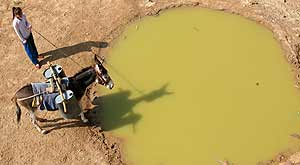Ningxia Tests Answer to Chronic Water Shortage
China Daily, July 17, 2012 Adjust font size:
Project saves time and money
Pipes about the width of a finger lie in the field under a thin layer of soil, with another layer of plastic film on top of them. Water coming out of the tiny holes in the pipes goes directly to the roots of the crops. Above the ground, pale yellow melons are coming in splendidly.
"That's a new type of melon we started to grow in recent years. It sells well, with its golden skin and sweet red pulp," said Li Yonghong, deputy head of the water resources bureau in Helan county in Yinchuan, the Ningxia Hui autonomous region.
Li is in charge of promoting high-efficiency water saving projects in the county. The fields she was referring to are the project's role model - Languang village.
Located at the end of two irrigation ditches, the village has a crop yield that has long been hurt by a shortage of water. With the help of local government, a project of pressurized drip irrigation has been in place since March.
"The water used now is only 10 percent of the amount before, but the crop yield has doubled," said Ma Haibing, a local villager in his 40s. He added that the money saved from electricity is also considerable because the water source for the village is underground.
The project covers 200 hectares and cost an investment of more than 3.5 million yuan (US$550,000). Before it was in place, more than 4,000 cubic meters of water were needed per hectare. Now it's less than 450 cu m, Li said.
The use of fertilizer is also down, which is good news for the farmers and the soil, said Li. She said fertilizer is now added into the water and pumped through the hoses to the roots of the crops directly, saving 970 yuan per hectare.
Another advantage of the high-efficiency water saving projects is that crops ripen sooner, about seven to 10 days on average, which brings higher prices during this period.
Finding a farmer working in the field is also harder than before. According to Li, the planting process has been shortened to three steps from six, with much less work and fewer people needed, saving almost 6,000 yuan per hectare on labor.
"People are earning more money from their land back at home and have even more spare time to find other work to do and earn extra cash," said Yang Xuewen, head of the village.
The village's per capita income in 2011 was more than 10,000 yuan, three times the figure back in 2007.


